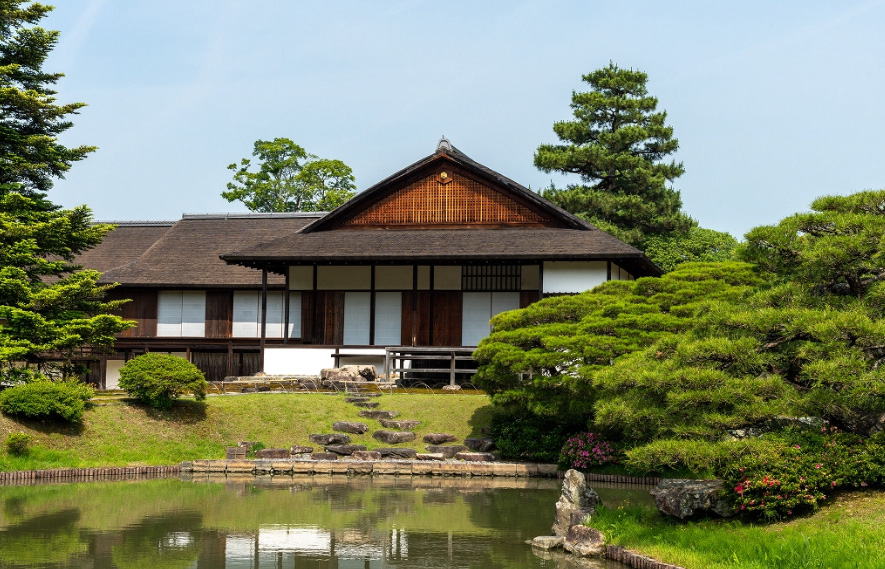Katsura Imperial Villa is a prime example of Japanese architecture and garden design, reflecting the elegance of the Japanese imperial family. This 17th-century villa, located on the Katsura River in western Kyoto, is renowned for its stunning landscape gardens.
Covering 69,400 square meters, with 4,186 square meters of buildings, the villa includes the main house (Shoin), Middle Shoin, New Palace, and other structures, all surrounded by meticulously designed gardens. It blends Shoin-zukuri and Sukiya-zukuri architectural styles, showcasing traditional Japanese art.
The garden features a “stroll garden” layout, offering varied views as visitors walk along paths surrounding the central pond. It uses the “borrowed scenery” technique to incorporate distant mountains, creating a sense of infinite space.
Katsura Imperial Villa is a cultural heritage site, embodying Japanese aesthetics and philosophy. Its principles of simple elegance and harmony with nature continue to influence modern architecture and landscape design.
Main Highlights
- A traditional Japanese garden perfectly blending nature and artifice
- Exquisite architectural art showcasing the essence of Japanese aesthetics
- Unique visiting experience, requiring advance reservation for guided tours
- Rich historical and cultural background, once a residence for imperial family members
Historical
Birth of the Royal Villa
Katsura Imperial Villa dates back to the early 17th century. In 1615, Prince Toshihito Hachijō-no-miya began its construction, drawing inspiration from tea ceremony aesthetics. His son, Prince Toshitada, expanded and renovated the villa, completing it by 1645. This period marked a golden age in traditional Japanese culture and art.
Perfect Combination of Architecture and Gardens
The villa embodies the Japanese concept of “unity of subject and object” and the aesthetic principle of “wabi-sabi.” It features advanced building techniques and a garden design that utilizes natural topography. The Shoin-zukuri and Sukiya-zukuri styles reflect influences from Chinese Song Dynasty and Japanese tea house architecture, respectively.
Later Influence and Protection
Neglected during the late Edo and early Meiji eras, the villa was rediscovered in the early 20th century by architect Itō Chūta, attracting international attention. In 1945, it was designated a “Special Place of Scenic Beauty” in Japan. Restoration efforts have since maintained its historical appearance, making it a valuable resource for studying traditional Japanese architecture and garden art.
Main Attractions
Central Garden
The garden design centered around the central pond is considered the pinnacle of Japanese garden art. As you stroll through the garden, you can admire carefully arranged rocks, small bridges, tea houses, and other landscape elements, each meticulously designed to showcase unique beauty in different seasons.
Moon Viewing Pavilion
The Moon Viewing Pavilion is one of the most famous buildings in Katsura Imperial Villa, inspired by the renowned Tale of Genji. This elegant structure overlooks the central pond, creating a poetic and picturesque scene on full moon nights when the moonlight reflects on the water surface.
Shoin
The Shoin is the main building complex of Katsura Imperial Villa, consisting of several interconnected rooms. Its simple yet refined design perfectly demonstrates the aesthetic principles of traditional Japanese architecture. Visitors can admire the architectural beauty of the Shoin from the exterior and appreciate its unique spatial layout.
Tea Houses
There are several tea houses scattered throughout Katsura Imperial Villa, each with its unique design and atmosphere. These tea houses are not only venues for tea ceremonies but also embodiments of traditional Japanese aesthetics and philosophical thought.
Best Time to Visit
Katsura Imperial Villa is beautiful in all seasons, but it’s particularly spectacular during cherry blossom season in spring and autumn foliage season. It’s advisable to avoid Japanese Golden Week and Obon Festival holidays for a quieter visiting experience.
Transportation Guide
Katsura Imperial Villa is located in western Kyoto. It can be reached in about 20 minutes by taking City Bus No. 33 from Kyoto Station and getting off at the “Katsura Rikyū-mae” stop. The fare is 270 yen and is not fully covered by the Kyoto City Bus One-Day Pass. Alternatively, you can walk about 15 minutes from Katsura Station on the Hankyu Kyoto Line.
Opening Hours and Ticket Information
- Opening hours: Open year-round, closed on Mondays (or the following day if Monday is a public holiday)
- Admission: 1000 yen per person
- Visiting method: Advance reservation required for guided tours
- Reservation methods:
- Apply in person at the Imperial Household Agency Kyoto Office in Kyoto Imperial Palace
- Online reservation through the Imperial Household Agency official website (limited spots, book several days in advance)
- A small number of same-day tickets are distributed at Katsura Imperial Villa (first-come, first-served)
Visitor Tips and Advice
- Make reservations in advance, especially during peak tourist seasons
- The tour lasts about 1 hour; wear comfortable walking shoes
- Follow tour guidelines; photography is only allowed at designated spots
- Prepare cash for admission fees; credit cards may not be accepted at the site
Official Website
Conclusion
Katsura Imperial Villa is a treasure of traditional Japanese culture and aesthetics, with its exquisite garden design and architectural art that leave visitors in awe. By visiting Katsura Imperial Villa, tourists can not only admire the beautiful architecture and garden landscapes but also gain a deeper understanding of the essence of Japanese culture and experience the elegance and taste of imperial life over the centuries. Whether you’re an architecture enthusiast, a garden lover, or a cultural explorer, Katsura Imperial Villa will offer you an unforgettable cultural journey. Stepping into this royal villa and experiencing the charm of traditional Japanese aesthetics is undoubtedly a highlight of your Kyoto trip that should not be missed.
